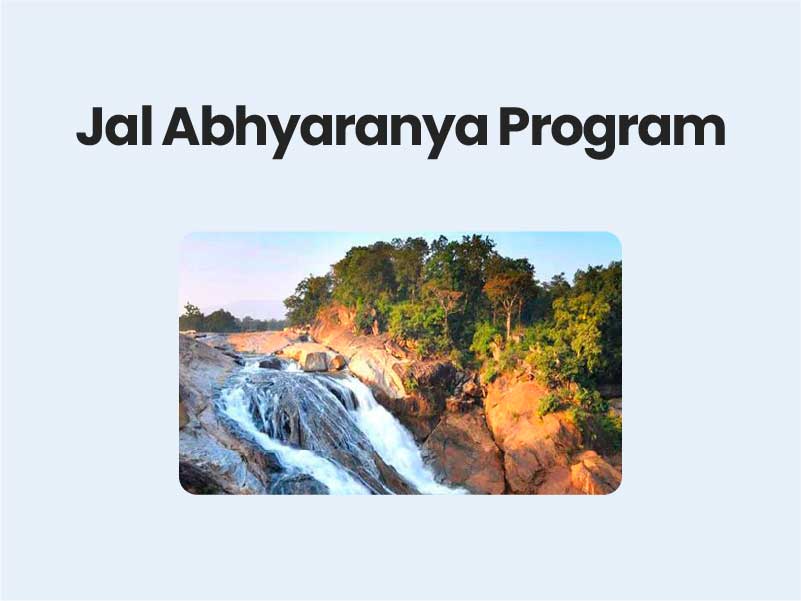Companion@360 → 7 Month programme to sharpen your writing skills → REGISTER NOW

Jal Abhyaranya Program
Mountain natural springs are the main fresh water sources which serve nearly 40 millions of people across the Himalayas.The water problems of hill towns like Shimla are a direct result of drying of springs.
According to one estimate, almost all 58,000 inhabited villages in IHR are dependent on the natural water springs or small streams originated from springs, of which at least half of the springs are drying up or have witnessed decline in water discharge resulting in acute water shortages across thousands of Himalayan villages and hill towns.
- GBPIHED through its various partners is taking lead in maintaining the Geo Database of spring inventory & developing demonstrative models of Gram Jal Abhyaranya in at least one village of selected districts of 12 IHR States that also include majorily the aspirational districts identified by NITI Ayog.
- This will help the Ministry of Environment, Forest and Climate Change, New Delhi in taking lead in launching a massive drive for Himalayan spring rejuvenation using Village Water Sanctuary (Gram Jal Abhyaranya) approach for rejuvenating at least one drying spring in each of the 58,000 villages with the active support of State Forest Departments and other Ministries and organizations.
Envisaged Outcome:
- Baseline data/information of mountain springs in terms of i.e. seasonal, dry-up and perennial spring and springs characteristics in inhabited villages of all 12 Himalayan States.
- Operational field demonstration models in each Aspirational Districts in all 12 IHR states for field training and capacity building and creation of 1200 para- hydrogeologists.
- Revival/Rejuvenation of dry up spring(s) in water stress area of Himalayan State using the Technology and Community based approaches through state agencies.
- State specific policy documents on conservation and management options for monitoring, protection, enhancement and restoration strategies for Springs.
Aspirational District for IHR:
Kupwara (Jammu Kashmir), Chamba (Himachal Pradesh), Champawat/Almora* (Uttarakhand), Darjeeling* (West Bengal), West Sikkim (Sikkim); Namsai (Arunachal Pradesh), Dima Hasao* (Assam), Kiphire (Nagaland), Chandel (Manipur), Mamit (Mizoram), Dhalai (Tripura), Ribhoi (Meghalaya).
Spring Rejuvenation:
Though the task of revival of Himalayan springs is gigantic, it can be achieved through a systematically coordinated, combined national, state and local level initiatives involving all possible stakeholders and partners including governments, community and people at large.
Read UPSC CSE Prelims 2022 Detailed Answer Key
Studies conducted by RM&DD, Government of Sikkim have showed that revival of springs is possible by taking up artificial ground water recharge works in the recharge area (springshed) of the aquifer. Based on the experiments, an eight-step action plan was designed which provides a step-by-step procedure for reviving Himalayan springs. These eight steps are as follows:
- Comprehensive mapping of springs and springsheds.
- Setting up of a data monitoring system.
- Understanding socio-economic and governance systems of springs.
- Hydrogeological mapping.
- Creating a conceptual hydrogeological layout of the springshed.
- Classification of spring type, identifying mountain aquifer and demarcating recharge area.
- Developing springshed management and governance protocols and
- Impact assessment.
Challenges:
- Community participation is key for long term sustainability of the program.
- Only supply side interventions are executed which may increase the water discharge for a short term but does not solve for water security in the long term.
- The convergence of schemes, efforts and funds remains a challenge.
- The knowledge remains in the hands of the experts and is not adequately transferred to the local community making the community dependent on the govt/experts.
- Availability of dedicated water resource personnel at the Panchayat or the village level will significantly improve the long term efficacy of the interventions.
- The existing programmes should have adequate funding for HR and capacity building of all the stakeholders in the programme.
- The programmes do not have adequate emphasis on the data collection. In absence of data, it is difficult to measure the impact of the interventions and learn from what worked and what did not work and learn from those experiences.
Way Forward:
- Participation: To consciously and actively engage the community during the entire programme by reducing the threshold to participation and make the interactions smooth and seamless.
- Long Term Assets: The programme should leave long term assets (institutional and physical) across the ecosystem that would last beyond the program.
- Leverage local knowledge: The design should leverage both science and local knowledge.
